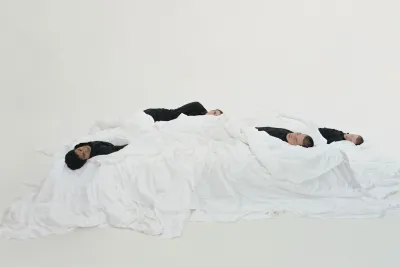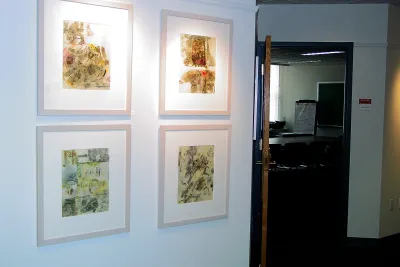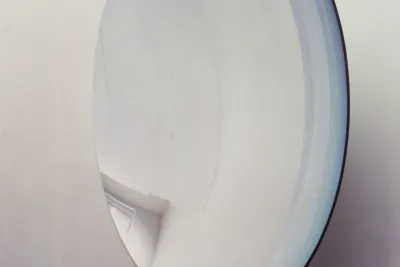Maria Friber, embedded #5, 2006. Image courtesy of Conner Smith.
Maria Friberg: Two Recent Works: Embedded (2006), Commoncause (2008)

Since the late 1990s, Maria Friberg has been looking long and hard at men in her video and photographic art works. She approaches them with the eye of a cultural anthropologist and depicts males as if they were an alien species with bizarre habits, movements, and ways of dressing. She aims her critical lens at the ways in which they seize space from each other and gather in packs.
Friberg visually dislocates men from their natural environments, sometimes throwing them against monochrome backgrounds or isolating them against, or inside of, repeated objects such as hundreds of books or a stack of tires. She exoticizes their movements and postures and to reveal the strange, yet globally comprehensible, meanings of their highly choreographed motions. The artist employs men’s suits—those dark fabric coverings that convey power while erasing difference and inscribing group identity—as artificial conspicuous costumes for the performance of daily life.
The MIT List Visual Arts Center is presenting two recent works from Friberg’s ongoing series of men in motion. The earlier work, Embedded (2006), was originally presented as a three-screen installation. The artist is allowing the List Visual Arts Center to excerpt the central panel as a stand-alone work for the specific context of the Media Test Wall. Each video segment is centered on an oversized bed, rendered as feminine in its luscious white satin drapery, from which clone-like gentlemen emerge swathed in identical suits.
Friberg employed a mix of dancers and advanced yoga practitioners to perform these difficult postures. The men emerge as vulnerable, prone creatures, wriggling off the bed in a stylized birth-ritual, and slithering to the floor. Their motions are like larva hatching from a nest. Like many animals, the men, once birthed, do not linger at the nest or interact with their littermates or symbolic mother, but move as quickly away and out of frame as their unformed awkward motions can transport them.
In Commoncause (2008) Friberg looks at the social problems and promise presented by masses of humans without any obvious bodies depicted. She wrapped 300 half-deflated basketballs in black velvet and rolled them down the steps of the Nationalmuseum in Stockholm. Their covering, which is similar to her costuming device of dressing her performers in dark suits, turns the balls into an undifferentiated mass of quasi-unique units, much like a hoard of people riding the subway or exiting a theater. The mysterious motion is accompanied by the sound of the actual event, which is reminiscent of distant thunder or a stampede, both of which are apt metaphors for the types of group-thought and activities that the artist intends this avalanche to conjure.
Maria Friberg was born in 1966 in Malmö, Sweden, and lives and works in Stockholm. She attended Royal University College of Fine Arts in Stockholm and has been showing internationally since the late 1990s. Her solo museum exhibitions include the Kulturhuset (2008) and Moderna Museet (2003), both in Stockholm. Outside of Sweden she has enjoyed monographic exhibitions at The Porin Taidemuseo in Finland; The Herbert F. Johnson Museum at Cornell University, Ithaca, New York (each 2005); The Santa Barbara Contemporary Arts Forum, Santa Barbara, California; and Plains Art Museum, Fargo, North Dakota (each 2002.) She is represented by Galleri Charlotte Lund in Stockholm, Conner Contemporary in Washington, D.C., Galica in Milano, and Galerie Voss in Düsseldorf.
Curatorial Essay
The Media Test Wall, an ongoing series of contemporary video exhibitions, is located in the Whitaker Building (21 Ames St., Building 56) on the MIT campus.This presentation of the Media Test Wall is generously supported by the Massachusetts Cultural Council, the Council for the Arts at MIT, and the Robert and Maurine Rothschild Fund.

